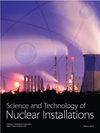基于反渗透膜富集预处理的水中总α / β活性快速测定
IF 0.9
4区 工程技术
Q3 NUCLEAR SCIENCE & TECHNOLOGY
引用次数: 0
摘要
总α / β放射性是水质检测的一项指标,能反映水体的放射性强度。但传统的粗源法检测这些参数存在制样繁琐、耗时等问题,无法实现现场快速检测。基于此,本文研究了基于反渗透膜的富集方法,以反渗透膜为载体,将水中的放射性核素富集到反渗透膜的高压侧,以替代传统厚源法的制样过程,准确、快速地测定水中的总α和总β。从而缩短检测过程中的样品处理时间,避免繁琐的样品制备过程。采用反渗透膜富集法测定gross在241Am和40KCl标准溶液中的α / β放射性,结果表明,gross α / β的平均放射性回收率分别为95.0%和93.6%。同时,比较了厚源法和反渗透膜法对5个不同地区实际水样的总α / β值的影响。结果表明,厚源法和反渗透膜法对总α和总β放射性的检测结果具有较好的一致性,且反渗透膜法比厚源法具有更好的稳定性。厚源法得到的总α和总β活性的平均相对标准偏差(RSD)分别为11.9%和7.3%,而反渗透膜法得到的总α和总β放射性的平均相对标准偏差(RSD)分别为6.9%和4.7%。单样品制备时间缩短75.7%,总检测周期缩短68.1%。本文章由计算机程序翻译,如有差异,请以英文原文为准。
Rapid Determination of Gross Alpha/Beta Activity in Water Based on Reverse Osmosis Membrane Enrichment Pretreatment
Radioactivity of gross alpha/beta is an index of water quality detection, which can reflect the radioactivity intensity of water. However, the traditional detection method of these parameters, thick source method, has problems of cumbersome and time consumption in sample preparation and cannot realize the rapid detection on-site. Based on this, this paper studies the enrichment method based on reverse osmosis membrane to accurately and quickly determine the gross α and gross β in water by using the reverse osmosis membrane as the carrier and enriching the radionuclides in water to the high-pressure side of the reverse osmosis membrane to replace the sample preparation process in traditional thick source method, so as to shorten the sample processing time in the detection process and avoid the cumbersome sample preparation process. The reverse osmosis membrane enrichment method for the determination of gross in 241Am and 40KCl standard solutions was used to study gross alpha/beta radioactivity, and the results showed that the average recoveries of radioactivity of gross alpha/beta were 95.0% and 93.6%, respectively. At the same time, the results of the thick source method and the reverse osmosis membrane method on the gross alpha/beta of actual water samples in 5 different regions were compared. It showed that the thick source method and the reverse osmosis membrane method had a good consistency in the detection results of total α and total β radioactivity, and the reverse osmosis membrane method had better stability than the thick source method. The average relative standard deviations (RSD) of the gross alpha and gross beta activity obtained by the thick source method are 11.9% and 7.3%, respectively, while RSD of the gross alpha and gross beta radioactivity obtained by the reverse osmosis membrane method were 6.9% and 4.7%, respectively. The preparation time of single sample was reduced by 75.7%, and the overall detection cycle time was reduced by 68.1%.
求助全文
通过发布文献求助,成功后即可免费获取论文全文。
去求助
来源期刊

Science and Technology of Nuclear Installations
NUCLEAR SCIENCE & TECHNOLOGY-
CiteScore
2.30
自引率
9.10%
发文量
51
审稿时长
4-8 weeks
期刊介绍:
Science and Technology of Nuclear Installations is an international scientific journal that aims to make available knowledge on issues related to the nuclear industry and to promote development in the area of nuclear sciences and technologies. The endeavor associated with the establishment and the growth of the journal is expected to lend support to the renaissance of nuclear technology in the world and especially in those countries where nuclear programs have not yet been developed.
 求助内容:
求助内容: 应助结果提醒方式:
应助结果提醒方式:


